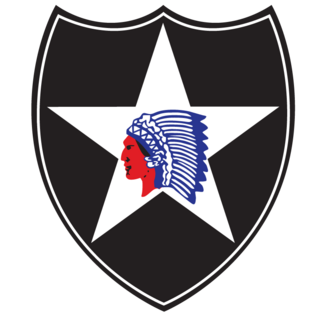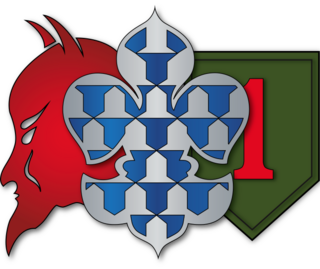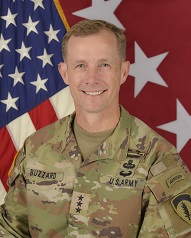
The 2nd Infantry Division ("Indianhead") is a formation of the United States Army. Since the 1960s, its primary mission has been the pre-emptive defense of South Korea in the event of an invasion from North Korea. Approximately 17,000 soldiers serve in the 2nd Infantry Division, with 10,000 stationed in South Korea, accounting for about 35% of the United States Forces Korea personnel. Known as the 2nd Infantry Division-ROK/U.S. Combined Division (2ID/RUCD), the division is bolstered by rotational Brigade Combat Teams (BCTs) from other U.S. Army divisions.

The 1st Infantry Division (1ID) is a combined arms division of the United States Army, and is the oldest continuously serving division in the Regular Army. It has seen continuous service since its organization in 1917 during World War I. It was officially nicknamed "The Big Red One" after its shoulder patch and is also nicknamed "The Fighting First". The division has also received troop monikers of "The Big Dead One" and "The Bloody First" as puns on the respective officially sanctioned nicknames. It is currently based at Fort Riley, Kansas.

The U.S. Military Assistance Command, Vietnam (MACV) was a joint-service command of the United States Department of Defense, composed of forces from the United States Army, United States Navy, and United States Air Force, as well as their respective special operations forces.

The 98th Infantry Division ("Iroquois") was a unit of the United States Army in the closing months of World War I and during World War II. The unit is now one of the U.S. Army Reserve's training divisions, officially known as the 98th Training Division. Its primary mission is to conduct Initial Entry Training (IET) for new soldiers. It is one of three training divisions subordinate to the 108th Training Command (IET) and handles command and control of units throughout the eastern United States and in Puerto Rico.

Military advisors or combat advisors are military personnel deployed to advise on military matters. The term is often used for soldiers sent to foreign countries to aid such countries' militaries with their military education and training, organization, and other various military tasks. The foreign powers or organizations may send such soldiers to support countries or insurgencies while minimizing the risks of potential casualties and avoiding the political ramifications of overtly mobilizing military forces to aid an ally.

The 1st Armored Brigade Combat Team, 1st Infantry Division is a maneuver brigade combat team (BCT) in the United States Army. It is the oldest permanent brigade in the Army and has some of the oldest units in the United States Army. Headquarters and Headquarters Company (HHC), 1st Brigade served in World War I, Vietnam, Desert Shield and Desert Storm. Its most notable campaigns include the Aisne-Marne, Meuse-Argonne, Picardy, Tet Counteroffensive and the Liberation and Defense of Kuwait. Since Desert Storm, the "Devil Brigade" has deployed to Bosnia, Kuwait, and to Korea to participate in a 2nd Infantry Division exercise.

The 5th Marine Regiment is an infantry regiment of the United States Marine Corps based at Marine Corps Base Camp Pendleton, California. It is the most highly decorated regiment in the Marine Corps and falls under the command of the 1st Marine Division and the I Marine Expeditionary Force.

XXIV Corps was a U.S. Army Corps-level command during World War II and the Vietnam War.
A Military Transition Team or Transition Team, commonly abbreviated as MiTT, in the context of the United States Military, is a 10 – 15 soldier team that trains foreign national and local security forces. The term has been used in the "War on Terror" to designate groups training the Iraqi Security Forces in particular. By comparison, Afghan Army and other Afghan security forces are mentored and trained by US Embedded Training Teams (ETTs) and the Operational Mentoring and Liaison Teams (OMLTs) of other nations.

The 45th Infantry Brigade Combat Team ("Thunderbird") is a modular infantry brigade combat team of the United States Army headquartered in Norman, Oklahoma. It is a part of the Oklahoma Army National Guard.

Below is an estimated list of the major units deployed within the Multi-National Force – Iraq and other United States military units that were operating in Iraq under the U.S. Central Command (USCENTCOM) in 2009, during the Iraq War.

Below is the disposition and structure of international military forces that were participating in the War in Afghanistan in November 2012, listing deployed units under the command of the International Security Assistance Force (ISAF), which controlled both combat and reconstruction operations. During its existence from 2001 to 2014, despite the photos in this article only showing American soldiers, marines and sailors, the ISAF comprised units from many countries, including: Albania, Armenia, Australia, Belgium, Canada, Croatia, Czech Republic, Estonia, Finland, France, Georgia, Germany, Hungary, Italy, Latvia, Lithuania, Macedonia, Netherlands, New Zealand, Norway, Poland, Romania, South Korea, Spain, Sweden, Turkey, United Kingdom and others. In this article, units are assumed to be from the United States unless otherwise stated. This list is a rough and unofficial listing of units and formations.

Embedded Training Teams or ETT is the term used by the US military since 2003 to describe conventional forces used to train and mentor Afghan forces. They were formed in 2003 under Task Force Phoenix. Although ETT refers to the Embedded Training "Team", members of the team itself commonly refer to themselves as "ETTs"

Dana James Hillian Pittard is a retired United States Army general officer. He served as Joint Force Land Component Commander-Iraq (JFLCC-I) from June 9, 2014, during the coalition response to the incursions by the Islamic State in Iraq and the Levant (Daesh) into Iraq from Syria. Pittard was deputy commanding general of operations (DCG-O) for ARCENT, the United States Central Command/Third Army, based in Kuwait, until 2015. He was also the commanding general of the 1st Armored Division and Fort Bliss in El Paso, Texas. He was also Deputy Chief of Staff of Operations & Training at the Training and Doctrine Command (TRADOC) at Fort Monroe, Virginia and commanding general of the National Training Center, Fort Irwin, California.
The United States Marine Corps' Anti-Terrorism Battalion was a specialized infantry battalion. The battalion was disbanded in 2013.

The 16th Infantry Regiment is a regiment in the United States Army and has traditionally been a part of the 1st Infantry Division.

James C. Yarbrough is a retired brigadier general in the United States Army.

John P. McLaren, Jr. is a retired United States Army major general.

Task Force Phoenix, or more properly known as Combined Joint Task Force Phoenix, was an international military formation. It was organized by the United States Central Command (CENTCOM) in 2003-2004 to train and mentor the newly created Afghan National Army/Afghan National Security Forces (ANSF) to establish and maintain law and order throughout Afghanistan using Embedded Training Teams or ETTs.

Curtis Alan Buzzard is a United States Army lieutenant general who has served as the commander of Security Assistance Group - Ukraine since August 2024. He most recently served as the commanding general of the United States Army Maneuver Center of Excellence and Fort Moore from July 2022 to July 2024. Prior to that, he served as the deputy chief of staff for operations, plans and training of the United States Army Forces Command from January 2022 to June 2022, and as the 78th Commandant of Cadets of the United States Military Academy from June 2019 to May 2021.


















